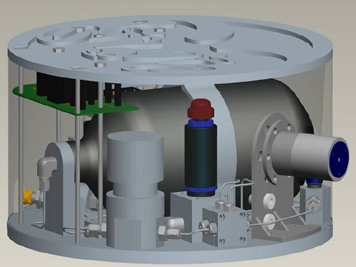CSU FAST Pallet is Key Component of Sounding Rocket Mission Set to Launch in 2009
 |
|
Graphic courtesy of NASA MSFC
|
Colorado State University mechanical engineering and engineering science students and faculty are hard at work developing the key component of a new satellite tether system set to launch in 2009. Working in conjunction with JAXA, the Japanese Aerospace Exploration Agency, CSU's FAST (FAst Starting Test) Pallet team is currently engineering a payload for a sounding rocket mission to facilitate the collection of electrons on a bare tether.
Typically made from high strength fibers and conducting wires, space tethers are integral not only in connecting spacecraft to each other or other objects, but are vital to advanced space acceleration and deceleration systems based on electodynamically generated forces. Tokyo Metropolitan University's Professor Hironori A Fujii, in conjunction with Les Johnson of NASA's Marshall Space Flight Center, is developing a new way to deploy such tethers in space, called the Foldaway Flat Tether Deployment System.
Relying on reverse origami, or an unfolding method to rapidly deploy the flat, gossamer tethers, the new constructs will be a different approach to the traditional braided wires on spools used in the past. CSU and JAXA hope to utilize remote regions of the bare tether to collect electrons from the ionosphere and test a concept proposed by Professor Juan Sanmartin, another collaborator on the project from the Department of Physics at the Universidad Politecnica de Madrid, in Spain. When employed on orbiting satellites, the current collected on a bare tether can be used to decelerate and de-orbit exhausted space stages and other debris, clearing the way for safer space missions in the future.
For deceleration to occur, an electrical connection must be made between one end of the tether and the ionosphere, the uppermost part of the atmosphere ionized by solar radiation. CSU's FAST Pallet team is currently developing a plasma-based electrical connection to ground the system. Utilizing a hollow cathode and xenon gas, an artificial plasma bridge can be made, electrically linking ionospheric space plasma and that of the cathode to create such a connection. According to Assistant Professor John Williams of the CSU mechanical engineering department, "the bare tether collects electrons from the ionosphere and directs them to the FAST pallet, which boils them back into the ionosphere."
"Our project is a critical component of this mission," said CSU engineering science student and team leader Meghan Capra. "If we don't work, the mission doesn't work; the experiment cannot be run without this piece [of hardware]."
The senior design team under the guidance of Williams and Dr. Binyamin Rubin took first place in the Demonstration Session at this year's Undergraduate Space Research Symposium, which is sponsored by the Colorado Space Grant Consortium. Students Matthew Larson, Steen Vecchi, Dan Strawn, Jeff Wyant and Meghan Capra each submitted a paper and individually conducted a demonstration for a panel of judges from both industry and academia. Williams rained praise on the students pointing out, "this team transferred CSU research on plasma contactors from laboratory curiosities into flight-ready hardware with the competency of seasoned NASA engineers. Next stop Mars!"
For more information on CSU's Mechanical Engineering Department and Space Program please visit the Electric Propulsion and Plasma Engineering Laboratory website at http://www.engr.colostate.edu/ionstand/index.html.
 |
|
FAST Pallet
|